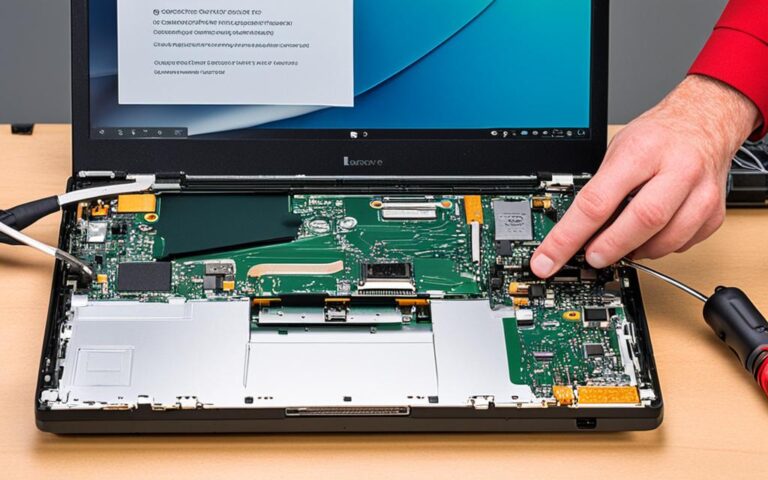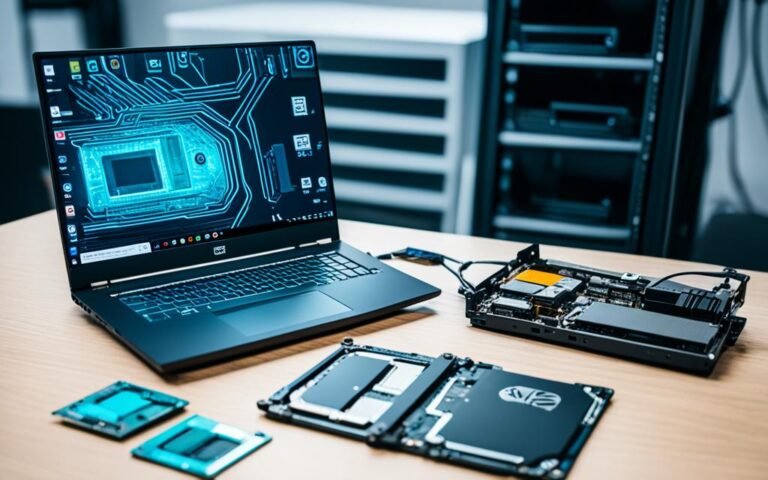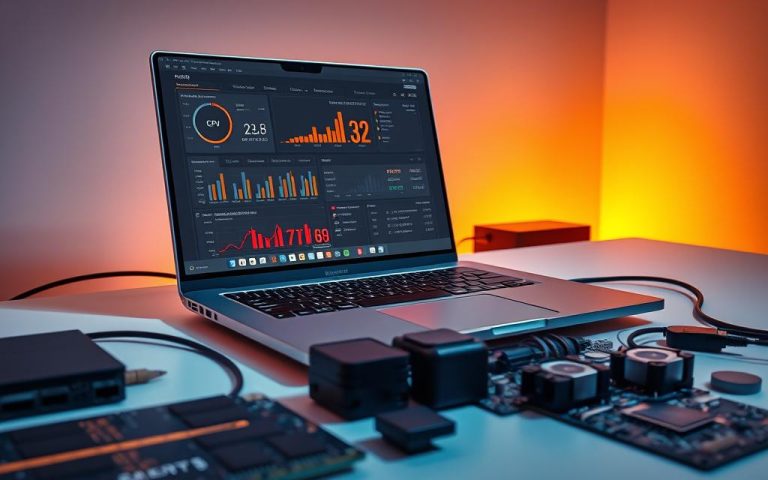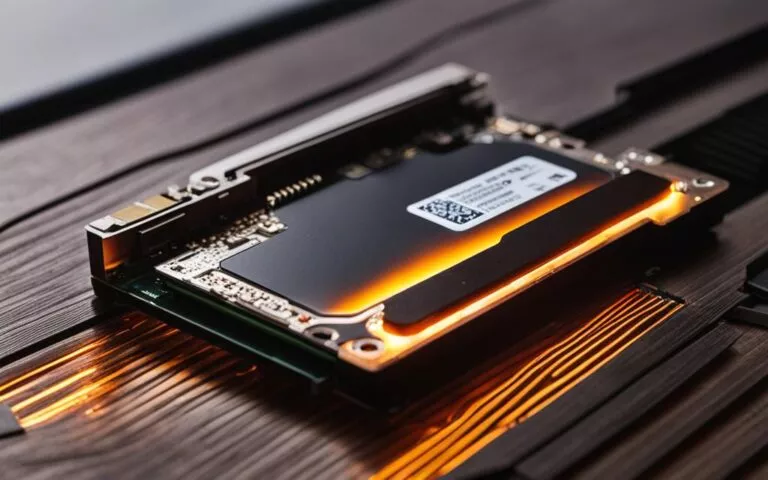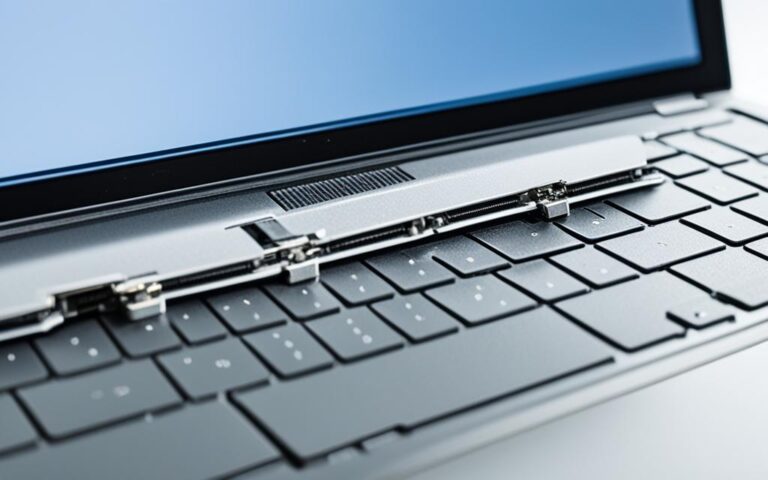How to Fix Flickering or Lines on Your Laptop Screen
A flickering screen or ugly lines on your laptop can really slow you down. This guide will walk you through laptop screen troubleshooting to get to the bottom of laptop display issues. You can figure out if the trouble comes from the hardware, software, or settings. Then, you’ll know how to fix the flickers.
Things like loose cables, old drivers, or damage from getting too hot or wet might be the cause. Following the right steps can solve your problem and help your laptop work better.
If you’re looking for more help, check out this link about fixing flickers in laptop backlit keyboards.
Understanding Screen Flickering and Lines
Screen flickering and lines can really ruin your day. Knowing why it happens is key to fixing it. This includes understanding the causes of screen flickering and finding ways to sort out flickering laptop screen issues.
What Causes Screen Flickering?
Screen flickering comes from a few issues:
- Overheating, damage to the monitor, or dodgy connections.
- Old graphics drivers messing up how your display works.
- Having the wrong screen resolution can cause screen flicker symptoms.
- Set the refresh rate wrong and your screen won’t look right.
- Broken parts inside could also mess up your screen.
Check out this handy guide for fixing horizontal lines on your screen.
Impact on User Experience
Flickers or lines on your screen can make using your laptop hard. They can cause eye pain and headaches. This makes using your laptop a lot less fun. And when your screen’s not right, getting work done is a struggle.
How to Isolate the Problem
Finding out what’s wrong with your screen, like flickers or lines, is key. You can figure out if it’s a software or hardware issue. Taking the right steps helps pinpoint the problem.
Taking a Screenshot
Taking a screenshot to diagnose screen issues is a smart move. Press the PrtSc button to capture your screen’s image. Place this screenshot into an image editor to see what’s wrong. If you spot flickers or lines in it, the display adaptor might be faulty. Make sure you have the latest driver for your laptop’s display. A clear screenshot means the issue could be the screen’s hardware. You might need to check the cables or think about getting a new screen.
Determine if it’s a Driver Issue
Figuring out if you have a driver issue is your next step. Update your graphics drivers because old ones can cause problems. Sometimes you have to update software regularly. If new updates make things worse, going back to an older version can help. Keep your driver software in good shape to prevent flickering linked to driver problems. Also, checking your laptop’s screen regularly helps keep it working well.
| Issue Type | Possible Cause | Next Steps |
|---|---|---|
| Lines in Screenshot | Display adapter malfunction | Update drivers from the manufacturer |
| No Lines in Screenshot | Potential hardware defect | Check cables or consider screen replacement |
| Flickering Display | Outdated graphics drivers | Check for driver updates or revert to an earlier version |
| Regular Maintenance Needed | Driver conflicts or hardware issues | Perform routine system checks and updates |
Quick Fixes for Screen Flickering
Screen flickering can make it hard to work and frustrate you. Luckily, you can try some easy fixes. These fixes can quickly improve your laptop’s performance and how you experience using it. Here are two good methods to stop screen flickering.
Restart Your Computer
Reboot to fix flickering is a simple way to solve many tech problems. Restarting clears temporary files and refreshes your computer. It often fixes display issues caused by background programs. A quick restart might just get rid of unexpected flickering.
Turn Your Monitor Off and On Again
Turning your display off and then back on is a simple fix. This acts like a reset monitor for fixing issues. It can remove small glitches that cause flickering. Often, this easy step fixes the problem without needing complicated repairs. It has helped many people get their screens back to normal quickly.

How to Fix Lines in Laptop Screen
Lines on your laptop screen can mean many things, like loose connections or wrong settings. Fixing these can make your screen look better. Here’s how to do it right.
Check Monitor Connections
First, make sure all the monitor connections are checked. Cables should be tightly plugged in and not damaged. A loose cable might cause your screen to flicker or show lines. Changing any damaged cables could make your display clearer. Always check your cables to keep your display looking good.
Change the Refresh Rate
Changing the refresh rate might solve flickering problems. If your laptop’s settings don’t match the display’s requirements, you could see issues. Adjust the refresh rate in your settings for the best performance.
Adjust Screen Resolution
Getting your screen resolution right is key for a clear display. If your laptop’s resolution doesn’t match your screen’s, you might see lines. Change this in your settings to possibly get rid of lines. The correct resolution can improve your viewing significantly.
| Action | Description |
|---|---|
| Check Monitor Connections | Verify all cables are secure and in good condition; replace faulty cables. |
| Change Refresh Rate | Adjust the refresh rate in settings to match your display’s capabilities. |
| Adjust Screen Resolution | Set the laptop display resolution to match the monitor’s native resolution. |
Advanced Troubleshooting Techniques
If your laptop’s screen keeps flickering or shows lines, you might need to try some detailed fixes. These go beyond simple solutions. They involve updating the system and adjusting display settings to get rid of the issues.
Update Device Drivers
It’s key to keep your laptop’s drivers updated for it to work well. Often, old graphics drivers can mess up your screen. By checking the Device Manager, you can spot and update old drivers. Make sure to update laptop drivers by downloading the newest ones from the manufacturer’s website. This step can stop the flickering and make your laptop run smoother.
Perform a System Update
Keeping your laptop’s system updated is very important. If it’s not up to date, you might see issues like flickering lines on your screen. Update your system through the settings. This keeps your software fresh.Laptop updates to fix issues are crucial for top-notch performance and avoiding screen trouble.
Calibrate Your Display
Adjusting your display properly can really improve how your screen looks. Play around with the brightness, contrast, and other settings to get it just right. Most systems have easy tools to calibrate laptop display. Using these tools can stop the flickering and make everything look better.
| Issue | Method | Description |
|---|---|---|
| Outdated Drivers | Update Device Drivers | Visit the manufacturer’s website to download the latest drivers for improved performance. |
| Software Conflicts | Perform System Update | Regularly update the operating system to avoid compatibility issues and improve performance. |
| Poor Display Quality | Calibrate Your Display | Use built-in tools to adjust screen settings for better visual clarity and colour accuracy. |
Conclusion
To fix flickering or lines on your laptop screen, start by finding out what causes them. It helps to check your connections, change refresh rates, and update device drivers. These steps often fix the problem.
For lines on the screen, it’s vital to understand about dead pixels and how screen resolution works. Damage or getting too hot can cause lasting issues. Meanwhile, lines that come and go might point to connection problems. Keeping up with regular care helps avoid these issues.
If fixing it yourself doesn’t work, it might be time to get help from a pro. Looking after your laptop well, and updating software, makes it work better. This means you’ll have less trouble using your digital tools.
FAQ
What causes screen flickering on a laptop?
Screen flickering happens for many reasons. Hardware problems like overheating or damage are common causes. Outdated graphics drivers or faulty connections can also cause it. Sometimes, conflicts between software and hardware settings might be the culprit.
How can screen flickering impact user experience?
Flickering screens can make users uncomfortable. They lead to eye strain and headaches. This can hurt how well you work or enjoy entertainment on your laptop.
How can I determine if the flickering is a driver issue?
Checking if it’s a driver issue is simple. First, press the PrtSc key to take a screenshot. If the screenshot shows the lines, then the display adapter might be the problem. If not, the screen itself could be faulty.
What are some quick fixes for screen flickering?
For a quick fix, try restarting your computer. This can get rid of small issues. Also, turning your monitor off and then on again might help.
How do I check monitor connections to fix lines on my screen?
Check all monitor connections are tight. Loose or damaged cables can lead to flickering. Replacing faulty cables is key for clear visuals.
What should I do if changing the refresh rate doesn’t work?
If changing the refresh rate doesn’t stop the flickering, try a different approach. Change the screen resolution in your display settings. This might fix the visual distortions.
How can I update device drivers to prevent flickering?
Keeping your graphics drivers updated is crucial. Use Device Manager to check for the latest drivers. Updated drivers improve performance and reduce flickering.
What are the benefits of performing a system update?
System updates can solve many problems, including flickering. They check for and fix software conflicts. Updated software ensures your laptop performs well.
How can I optimise my display settings?
To optimise your display, adjust settings like brightness and contrast. This enhances your visual experience and might fix flickering. Use the calibration tools provided by your operating system to help.







